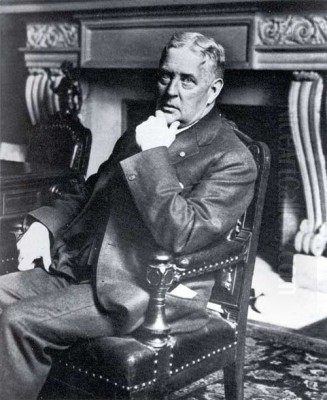
Edmund Charles Tarbell stands as a pivotal figure in American art history, celebrated primarily as a leading American Impressionist painter and a dominant force within the influential Boston School. Active during the late nineteenth and early twentieth centuries, Tarbell earned acclaim for his exquisite sensitivity to light and atmosphere, often captured within serene domestic interiors and refined portraits. His work skillfully blended the rigorous draftsmanship inherited from his academic training with the vibrant palette and broken brushwork characteristic of Impressionism, creating a style that was both modern and deeply respectful of artistic tradition. As an artist and a highly respected educator, Tarbell left an indelible mark on the trajectory of American painting.
Early Life and Formative Years
Edmund Charles Tarbell was born on April 26, 1862, in West Groton, Massachusetts. His early life was marked by upheaval; his father, Edmund Whitney Tarbell, passed away from typhoid fever during the Civil War. Following his father's death, his mother, Mary Sophia Fernald Tarbell, remarried and moved to Milwaukee, Wisconsin, leaving young Edmund and his sister, Nellie Sophia, in the care of their paternal grandparents in Groton, a town near Boston. This upbringing in a stable, albeit less conventional, family setting likely influenced his later focus on domestic themes.
Showing artistic promise at a young age, Tarbell's formal training began not in a fine art academy, but with a practical apprenticeship. From 1877 to 1880, he worked at the Forbes Lithographic Company in Boston. This experience provided him with fundamental skills in drawing and composition, grounding his later artistic endeavors in solid craftsmanship. However, his ambition lay in painting, leading him to enroll in the School of the Museum of Fine Arts, Boston (SMFA).
At the SMFA, Tarbell studied under Otto Grundmann, a German artist who emphasized rigorous academic principles of drawing and form. Grundmann's teaching provided Tarbell with a strong technical foundation, which would remain a hallmark of his work even as he embraced more modern styles. The Boston art scene during this period was vibrant, absorbing influences from Europe while cultivating its own distinct identity, providing a stimulating environment for the young artist.
Parisian Sojourn and Impressionist Awakening
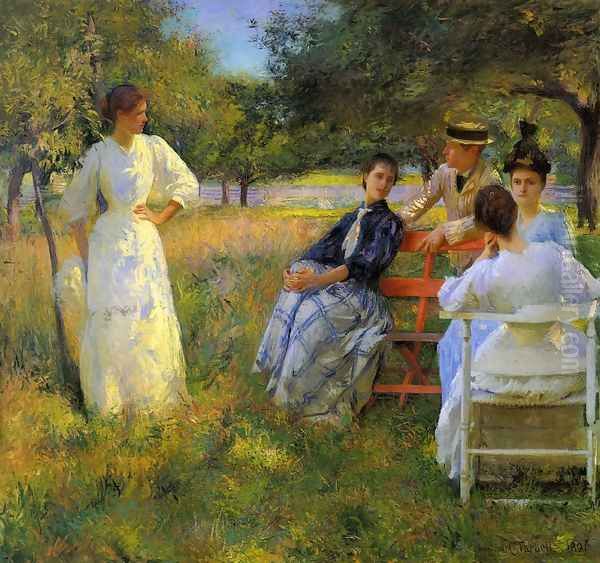
Like many ambitious American artists of his generation, Tarbell sought advanced training in Paris, the undisputed center of the art world. From 1884 to 1886, he studied at the prestigious Académie Julian, a private art school known for attracting international students. There, he received instruction from prominent academic painters Gustave Boulanger and Jules Joseph Lefebvre. These instructors reinforced the importance of anatomical accuracy, classical composition, and polished finish, further honing the skills he had acquired under Grundmann. Some accounts also mention William-Adolphe Bouguereau as an influential figure during his Parisian studies.
However, Paris offered more than just academic instruction. Tarbell was exposed to the revolutionary currents of French Impressionism. He encountered the works of artists like Claude Monet, Edgar Degas, and Pierre-Auguste Renoir, whose radical approaches to light, color, and capturing fleeting moments profoundly impacted him. He also spent time studying the Old Masters at the Louvre, developing a particular admiration for the Dutch painter Johannes Vermeer, whose mastery of interior light and quiet domestic scenes would resonate deeply in Tarbell's later work. Other masters like Velázquez also captured his attention.
This period abroad was transformative. While retaining his respect for solid drawing and composition, Tarbell began to experiment with the brighter palette, looser brushwork, and emphasis on capturing the transient effects of light that characterized Impressionism. He returned to the United States not as a strict academician, but as an artist poised to synthesize tradition with modernity.
Return to Boston: Establishing a Career
Upon returning to Boston around 1886, Tarbell began to establish himself professionally. He opened a studio and initially supported himself through illustration work, teaching private lessons, and painting portraits. Portraiture would remain an important aspect of his career, valued for both its artistic challenges and its financial stability. His skill in capturing not just a likeness but also the sitter's personality quickly gained him recognition.
In 1888, Tarbell married Emeline Arnold Souther, who belonged to a prominent Dorchester family. Emeline and their four children – Josephine, Mercie, Mary, and Edmund Arnold Tarbell – became his most frequent and cherished subjects. His depictions of his family in intimate, everyday settings form the core of his oeuvre, showcasing his evolving Impressionist style and his deep affection for domestic life. These works moved away from formal portraiture towards capturing candid moments illuminated by natural light.

A significant turning point came in 1890 when Tarbell, alongside his close colleague Frank W. Benson, began teaching at the School of the Museum of Fine Arts, Boston. His appointment marked the beginning of a long and influential teaching career. He quickly became the head of the painting department, shaping the instruction and influencing a generation of young artists who came to be known as the "Tarbellites."
The Boston School and Tarbell's Style
Tarbell, along with Frank W. Benson, became a leading figure of what is known as the Boston School of painting. This group, flourishing primarily in the first two decades of the 20th century, developed a distinctive regional interpretation of Impressionism. While embracing the Impressionist concern for light and color, the Boston School artists maintained a strong emphasis on academic draftsmanship, careful composition, and often depicted subjects related to the refined, genteel life of upper-class Boston society.
Tarbell's mature style epitomizes the Boston School aesthetic. His paintings are characterized by a harmonious blend of traditional structure and Impressionist technique. He demonstrated a remarkable ability to render the effects of light, particularly sunlight filtering through windows into elegantly appointed interiors or dappling figures in outdoor settings. His brushwork, while often loose and suggestive, always defined form clearly. His color palettes were typically high-keyed but controlled, creating an atmosphere of tranquility and refinement.
The influence of Vermeer is palpable in many of Tarbell's interior scenes. Like the Dutch master, Tarbell excelled at depicting figures absorbed in quiet activities – reading, writing, sewing, or playing music – within beautifully lit rooms. He shared Vermeer's sensitivity to the way light models form, reflects off surfaces, and creates a palpable sense of space and atmosphere. However, Tarbell's approach incorporated the brighter colors and more visible brushstrokes of Impressionism, giving his work a distinctly modern feel compared to his 17th-century predecessor.
The Ten American Painters
In 1897, Tarbell became a founding member of an important group known as the "Ten American Painters," or simply "The Ten." This group seceded from the larger, more conservative Society of American Artists, primarily due to dissatisfaction with the Society's large, juried exhibitions, which they felt had become overly commercial and unwelcoming to more progressive styles. The Ten sought smaller, more harmonious exhibitions where they could showcase their work according to their own aesthetic standards.
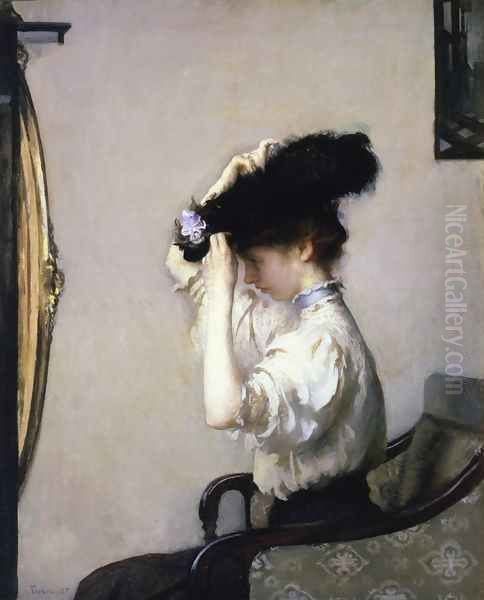
The founding members included Tarbell, Frank W. Benson, Childe Hassam, J. Alden Weir, Thomas Dewing, Robert Reid, Willard Metcalf, Edward Simmons, Joseph DeCamp, and John Henry Twachtman. After Twachtman's death in 1902, William Merritt Chase joined the group. These artists represented some of the leading figures in American Impressionism and Tonalism.
The Ten held annual exhibitions from 1898 until 1919, primarily in New York City, but also in Boston and other cities. Their shows were generally well-received critically and helped to solidify the place of Impressionism within the American art establishment. Tarbell was a consistent and prominent exhibitor with The Ten, showcasing many of his signature works depicting elegant women, often his own family members, in sunlit interiors or plein-air settings. His participation cemented his reputation as a leader of American Impressionism.
Masterpieces of Light and Domesticity
Tarbell's reputation rests significantly on a series of paintings created between the 1890s and the 1920s that masterfully explore themes of domesticity, leisure, and the effects of natural light. These works often feature his wife and daughters as models, lending them an air of intimacy and authenticity.
In the Orchard (1891): An early example of his developing Impressionist style applied to an outdoor scene. It depicts members of his family relaxing under dappled sunlight in an orchard. The painting showcases his growing interest in capturing the fleeting effects of light and atmosphere using broken brushwork and a brighter palette, clearly influenced by French Impressionism, perhaps recalling works by Monet or Renoir in its subject matter and handling of light.
Josephine and Mercie (c. 1908): This beloved painting shows two of his daughters, Josephine and Mercie, seated near a window, possibly looking at prints or drawings. Light streams in, illuminating the figures and the refined interior. The composition is informal yet carefully structured, and the interplay of light and shadow is rendered with remarkable subtlety. It exemplifies Tarbell's ability to capture a quiet, contemplative moment with both tenderness and technical brilliance.
Girl Reading (c. 1909): One of several works on this theme, it typically depicts a young woman absorbed in a book, often seated near a window. These paintings highlight Tarbell's fascination with interior light and his admiration for Vermeer. The compositions are often serene and balanced, emphasizing the quiet dignity of the subject and the beauty of the light-filled space.
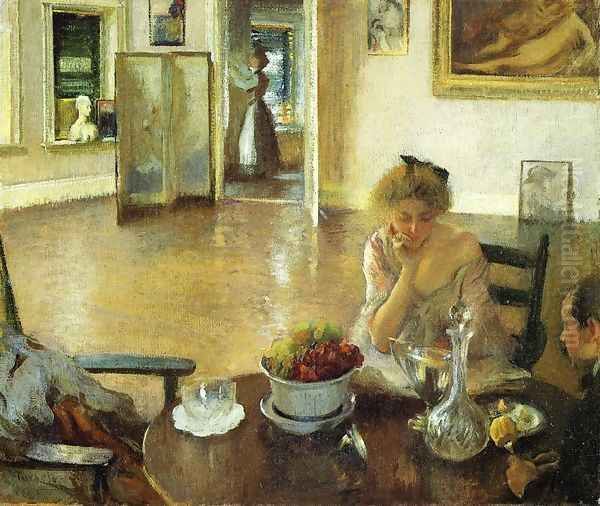
Mother and Mary (1922): A later work showing his wife, Emeline, seated reflectively while their daughter Mary stands behind her, perhaps arranging flowers. The painting is a masterful study of indoor light, with soft illumination defining the figures and the elegant furnishings. It demonstrates Tarbell's mature style, characterized by sophisticated composition, harmonious color, and a profound sense of tranquility, still echoing the spirit of Vermeer.
These and similar works cemented Tarbell's fame as a painter of genteel American life, celebrated for his technical skill and his poetic rendering of light and atmosphere.
A Celebrated Portraitist
Beyond his Impressionist scenes of domestic life, Tarbell was also a highly sought-after portrait painter throughout his career. He received numerous commissions to paint prominent figures in society, academia, and politics. His portraits combined the accurate likeness valued in traditional portraiture with the lively brushwork and sensitivity to light characteristic of his Impressionist work.
His approach to portraiture often involved placing his sitters in natural, comfortable poses, sometimes within environments that reflected their status or personality. He aimed to capture not just their physical features but also a sense of their character and inner life. While perhaps lacking the flamboyant bravura of his contemporary John Singer Sargent, Tarbell's portraits possess a quiet dignity, psychological insight, and technical refinement that earned him great respect.
He painted portraits of notable figures such as Presidents Woodrow Wilson, Calvin Coolidge, and Herbert Hoover, as well as numerous university presidents, businessmen, and society figures. These commissions provided significant income and further enhanced his public reputation. His ability to satisfy the demands of formal portraiture while retaining his distinctive artistic style speaks to his versatility and skill.
Teaching and Enduring Influence
Tarbell's impact on American art extends significantly beyond his own paintings. His long tenure at the School of the Museum of Fine Arts, Boston, from 1890 until 1912, established him as one of the most influential art educators of his time. Together with Frank W. Benson, he shaped the school's curriculum, emphasizing rigorous training in drawing ("art of accuracy") combined with the direct observation of nature and the study of light effects ("art of beauty").
His students, often referred to as "Tarbellites," absorbed his methods and aesthetic principles. Many went on to successful careers, carrying forward the Boston School's emphasis on craftsmanship, refined subjects, and the sensitive depiction of light. Notable artists influenced by Tarbell include William McGregor Paxton, Philip Leslie Hale, Lilian Westcott Hale, and numerous others who contributed to the continuation of the Boston School tradition well into the 20th century.
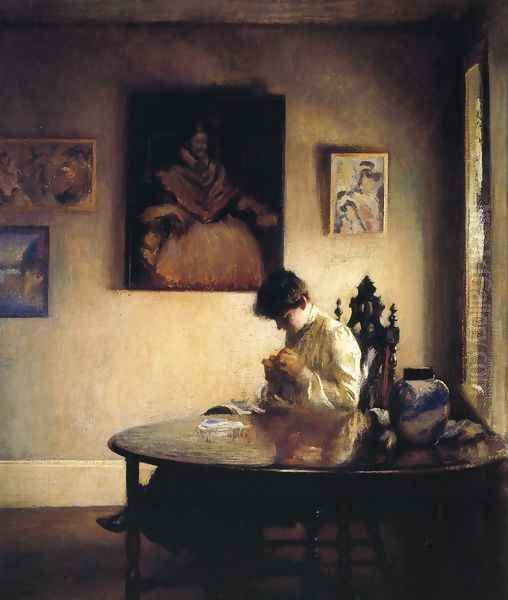
Tarbell's teaching philosophy stressed the importance of mastering the fundamentals before developing a personal style. He encouraged students to paint directly from life and to pay close attention to values (the relative lightness or darkness of colors) as the key to achieving convincing representations of form and light. His departure from the SMFA in 1912, along with Benson, following disagreements with the administration, marked the end of an era, though his influence persisted.
Later, from 1918 to 1926, Tarbell served as the Principal of the Corcoran School of Art in Washington, D.C., further extending his educational impact. His dedication to teaching helped shape the course of representational painting in America for decades.
Interactions with Contemporaries
Tarbell was an active participant in the American art world and maintained relationships with many leading artists of his day. His closest professional association was undoubtedly with Frank W. Benson, his colleague at the SMFA and fellow leader of the Boston School and The Ten. Their careers ran parallel in many ways, and they shared a similar artistic outlook.
As a member of The Ten, he regularly exhibited alongside Childe Hassam, J. Alden Weir, Thomas Dewing, Robert Reid, and others, fostering a sense of camaraderie and shared purpose among this group of prominent Impressionists. They represented a significant force advocating for modern, yet refined, artistic expression in America.
In Boston, Tarbell was a contemporary of John Singer Sargent, arguably the most famous American painter of the era. While Sargent's cosmopolitan background and dazzling technique set him somewhat apart, both artists moved within the city's elite social and artistic circles. Tarbell admired Sargent's work, and while their styles differed – Sargent's more virtuosic and flamboyant, Tarbell's quieter and more focused on intimate light effects – they shared a commitment to representational painting and portraiture.
Tarbell's circle also included his former teachers like Otto Grundmann in Boston, and Gustave Boulanger and Jules Joseph Lefebvre in Paris, whose academic training provided the foundation upon which he built his Impressionist explorations. His engagement with the art of the past, particularly Vermeer, and his awareness of contemporary European movements like Impressionism (Monet, Degas) demonstrate his broad artistic context. He operated within a rich network of influences and interactions that shaped his development and his place in art history, alongside other major American figures like Winslow Homer or Mary Cassatt, even if their direct interactions were limited.
Later Years, Honors, and Legacy
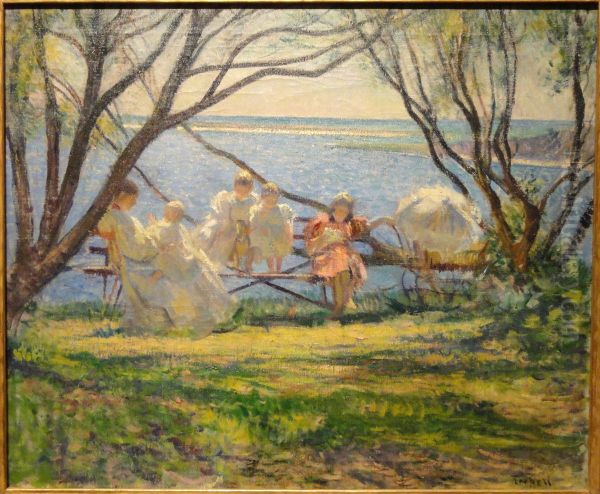
In his later career, Tarbell continued to paint actively, dividing his time between Boston and his summer home in New Castle, New Hampshire. The coastal light and relaxed atmosphere of New Castle provided inspiration for many of his later works, which often featured outdoor scenes and portraits set against the backdrop of his seaside home and garden. His style remained largely consistent, though some later works show a slightly broader handling.
Tarbell received numerous accolades throughout his career, affirming his status in the American art establishment. He was elected a full member of the National Academy of Design in 1906 and became a member of the prestigious American Academy of Arts and Letters. In 1929, Dartmouth College awarded him an honorary Doctor of Fine Arts degree. He served on art juries and remained a respected voice in artistic matters.
Edmund C. Tarbell passed away on August 1, 1938, in New Castle, New Hampshire. He left behind a significant body of work that continues to be admired for its technical mastery, aesthetic beauty, and evocative portrayal of a specific era in American life. His legacy endures not only through his paintings but also through his profound influence as a teacher who shaped the Boston School and guided a generation of artists. His personal papers, including diaries and correspondence, are preserved in the Archives of American Art, Smithsonian Institution, providing valuable insights into his life and work, thanks in part to donations from his family, including his great-grandson William P. Tarbell.
Collections and Market Presence
Today, Edmund C. Tarbell's paintings are held in the permanent collections of major museums across the United States. Institutions with significant holdings include the Museum of Fine Arts, Boston (which holds a particularly strong collection, given his ties to the city and the museum school); the Metropolitan Museum of Art, New York; the National Gallery of Art, Washington, D.C.; the Smithsonian American Art Museum; and the Corcoran Collection, now part of the National Gallery of Art.
Other important collections featuring his work include the De Young Museum in San Francisco, the Worcester Art Museum in Massachusetts, the New Britain Museum of American Art in Connecticut, and many university art galleries and private collections. The widespread institutional representation reflects his historical importance and enduring appeal.
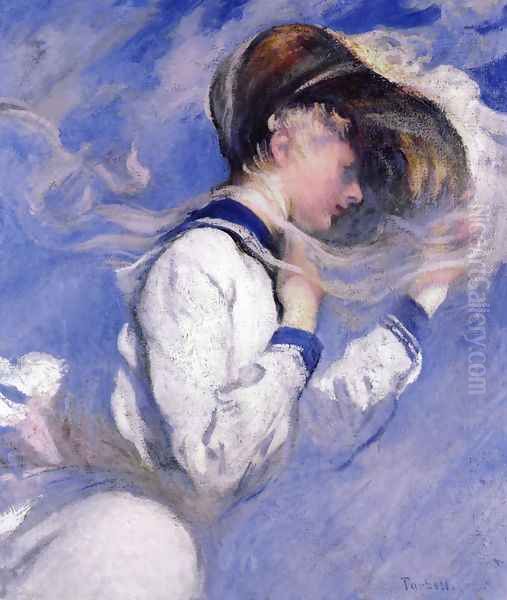
In the art market, Tarbell's works remain highly sought after, particularly his signature Impressionist interiors and plein-air scenes featuring his family. Major paintings command significant prices at auction, reflecting his status as a key figure in American Impressionism. While auction results vary depending on the specific work's quality, subject matter, provenance, and condition, important pieces consistently achieve strong results. For instance, studies or preparatory works can fetch substantial sums, as seen with the reported $200,000 sale of Study for Mary and New Castle Poppy. His finished exhibition pieces are among the most valued examples of the Boston School.
Conclusion
Edmund Charles Tarbell occupies a distinguished place in the annals of American art. As a painter, he masterfully synthesized the discipline of academic training with the light-filled palette and atmospheric concerns of Impressionism. His depictions of refined domestic life, particularly his intimate portrayals of his own family, are celebrated for their technical brilliance, sensitivity to light, and serene beauty. As a leader of the Boston School and a founding member of The Ten American Painters, he played a crucial role in shaping the direction of American art at the turn of the twentieth century. Furthermore, his long and influential career as an educator at the School of the Museum of Fine Arts, Boston, and the Corcoran School of Art left an enduring legacy, shaping generations of representational painters. Tarbell's art continues to resonate with viewers today, admired for its elegance, craftsmanship, and timeless evocation of light and life.